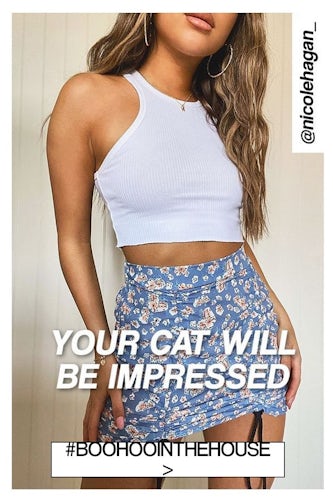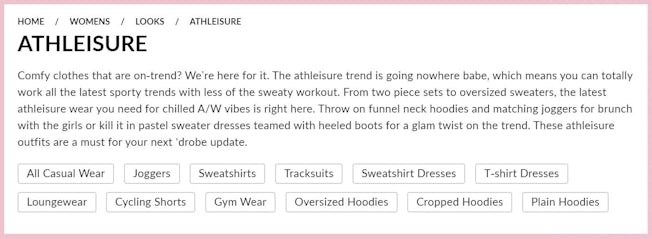While fashion and clothing brands of every kind including Cath Kidston, Laura Ashley, Debenhams and even Boohoo rival Asos have suffered major blows to their businesses as consumers stay at home with little to no incentive to buy new outfits, Boohoo seems to be bucking the trend.
Although Boohoo sales initially slumped along with its fellow fashion brands when lockdown measures were first implemented, the retailer is now enjoying an uptick in sales, and in April, it posted positive yearly results, with revenue up 44%, gross profit up 42%, and £125 million EBITDA, up 50%. It has even been held up as an example of what Primark might have been with a stronger (or any) ecommerce business, given that Boohoo’s founders previously supplied Primark:
Boohoo announced their yearly results today.
– Revenue up 44%.
– Gross profit up 42%.
– £125m EBITDA, up 50%.Interesting also in context of some people saying Primark's merchandise could never work for ecommerce. (Boohoo's founders previously supplied Primark) pic.twitter.com/QtQ6beJLiC
— dan barker (@danbarker) April 22, 2020
On 15th May, it was also revealed that Boohoo intends to raise up to £200 million worth of funds through share placing – and that it is eyeing potential acquisitions that might arise as a result of the Covid-19 crisis.
But things could have easily gone the other way for Boohoo, and being an established pure-play online retailer alone can’t explain its success (although it has undoubtedly helped). How has Boohoo managed to so successfully navigate the coronavirus crisis where others have struggled and failed? I’ll explore some of the likely contributing factors to Boohoo’s remarkable success, including a clever hashtag, uplifting and aspirational social content, and a strong brand tone of voice.
#BoohooInTheHouse
While many brands have developed – or attempted to develop – messaging around social distancing and the pandemic, Boohoo’s #BoohooInTheHouse hashtag is one of the more effective examples I’ve come across, as it reflects a wider shift in Boohoo’s messaging as a brand and how it presents its products.
Far from being just a social media hashtag, #BoohoointheHouse is a dedicated collection of “stay-at-home looks that will make everything a little easier right now … From the must-have casual wear pieces all our boohoo babes are loving right now to trending tops and dresses that make comfy look cute”. Boohoo’s website is full of messaging geared towards the idea of looking glam at home, from a jazzy banner promoting “new stuff to prance around the house in” to imagery of models wearing comfortable-looking tops, hoodies and drawstring trousers, to messaging like “Your cat will be impressed” and “No pants necessary”.

With #BoohooInTheHouse, Boohoo has managed to nail what women (its primary customer base) are looking for in the current crisis: clothing to make things easy, taking the stress out of finding what to wear in an unprecedented crisis; and ways to feel good about their appearance while also feeling comfortable. (As a side note, Boohoo has embraced similar messaging for its Boohoo Man menswear brand, promoting casual hoodies and “chill” styles, although without the #BoohooInTheHouse branding).
The hashtag appears across Instagram, Facebook and Twitter to promote casual looks worn by Boohoo’s models and influencers (known as ‘Boohoo Babes’) and giveaways of loungewear sets. On Instagram, Boohoo is also using #BoohooInTheHouse to promote its Instagram Live content, which includes nail art masterclasses, live DJ sets, Q&As with its influencers and other shows to engage and entertain people during lockdown.
A strong brand tone
While this isn’t just confined to the coronavirus pandemic by any means, Boohoo’s strong brand tone – funny, laid-back and slangy, the kind that you would use to message a friend – has been a major asset in the midst of the crisis, as it gives the brand a relatable, approachable and friendly vibe and makes its social media accounts fun to follow.
Alongside promoting its clothing ranges and advertising discounts, Boohoo’s social media accounts feature plenty of content completely unrelated to sales or clothing, like pictures of desserts and fast food, gifs about pets, funny or cute videos, and generally ‘relatable’ posts:
Quite excited I won’t lie to you ???? https://t.co/kCE3w36Kfi
— boohoo (@boohoo) May 12, 2020
The first night out after lockdown pic.twitter.com/hgXrkJQuqu
— boohoo (@boohoo) May 12, 2020
Content like this shows exactly how well Boohoo understands its customer base and their interests, and gives people a reason to follow Boohoo’s social channels, engage with the brand and boost its posts beyond interest in the clothing. And while interest in Boohoo’s clothing is the most important thing for driving sales, the bigger Boohoo’s audience, the more people are likely to encounter its contests and giveaways, be introduced to the brand for the first time, and potentially make a purchase further down the line.
While it’s not a strategy that would necessarily work for every type of brand – particularly high-end brands that thrive on an image of exclusivity and unattainability – it’s a solid strategy for Boohoo, a budget brand that aspires to be an accessible and fun part of people’s everyday lives.
The copy across Boohoo’s website projects the same fun, laid-back tone, and while the majority of shoppers aren’t going to be paying close attention to the copy, all of it contributes to and reinforces the overall feel of the brand.

Uplifting and aspirational content
It’s a good idea for brands to adapt their tone and messaging to the current situation so as not to seem vastly out of step with what consumers are thinking and feeling – but that doesn’t mean they should give up on content that inspires them. Consumers don’t always want to be reminded of the grim reality of a pandemic when they browse the internet or go on social media – they want to be uplifted and given an escape.
Although none of Boohoo’s posts promote flouting social distancing rules, the brand will show its models enjoying the sunshine, wearing glamorous outfits while making cocktails at home, or ask its followers what they most look forward to doing after the lockdown has eased – a type of aspirational content for the coronavirus crisis.
Discounts, contests and giveaways
As I’ve already mentioned, Boohoo runs regular contests and giveaways on its social media pages, inviting people to follow its accounts and post with a particular hashtag – or engage with a simple game or puzzle and respond with the answer – to enter and potentially win a prize. It also frequently runs sales on its website and promotes discount codes on social media.
Boohoo is far from the only fashion brand offering discounts in the pandemic: many brands are hoping to lure shoppers in with deep discounts, and as a result of this ecommerce sales for fashion brands have seen some recovery in April, but with a drop in average order value. Discounting can be a double-edged sword, with shoppers incentivised to make a purchase but brands losing out on profits – and it becomes harder to put prices back up to their normal level once shoppers are used to paying less for goods.
However, for the moment, Boohoo’s profits look healthy, and as I mentioned earlier, the giveaways have the potential to boost its overall reach and engagement in a way that benefits the brand long-term. Additionally, if Boohoo can keep making sales – even at a discount – instead of having clothing pile up in warehouses unsold, it’s likely to be better off.
In the midst of a crisis, with the majority of retailers – particularly fashion retailers – struggling to make sales, success is always going to be relative. However, for the moment it seems as though Boohoo has found a solid strategy for moving with the times and continuing to be relevant to shoppers even in the midst of massive change and uncertainty.

Comments